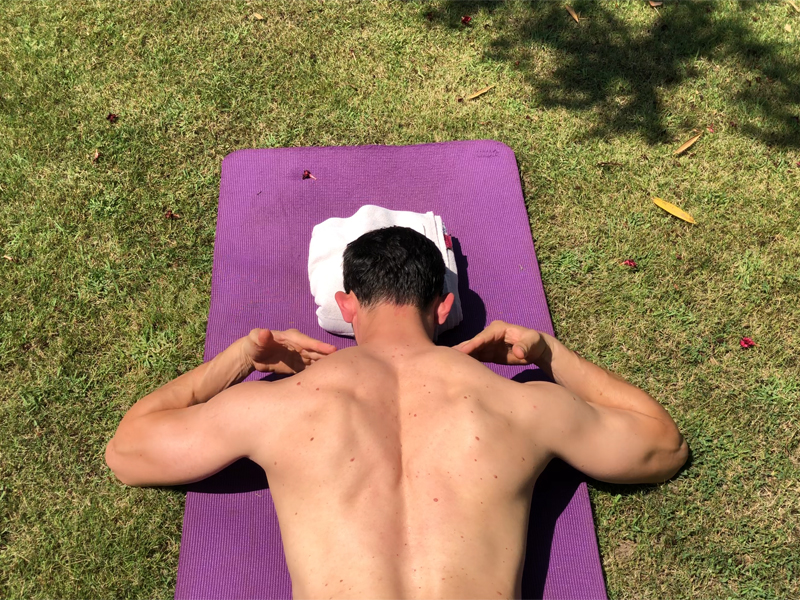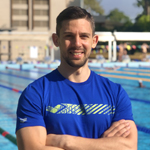5 exercises to improve posture and decrease the risk of shoulder injury
A high percentage of swimmers have experienced shoulder pain during their career. In fact, 47% of collegiate swimmers claim to have experienced shoulder pain persisting for 3 weeks or more. Sadly, most adolescent swimmers report the use of pain medication to alleviate these symptoms, believing that shoulder pain is normal and tolerable.
The “swimmer’s shoulder” is the sport-specific term used to describe this type of pain which includes several pathologies such as rotator cuff tendinitis, shoulder instability and shoulder impingement.
The exact cause of a swimmer’s shoulder is unknown, but several theories have been proposed including decreased subacromial spacial distance, scapular dysfunctions, altered muscle recruitment patterns, posterior capsule tightness, humeral head displacement, and altered physical characteristics.
Most competitive swimmers train 11 months per year, swim approximately 10,000-12,000 metres each day, and rotate their shoulders over 16,000 times each week.
The high physical demand of this level of training may cause changes to some physical characteristics, which can then predispose these athletes to a higher risk of injury.

Check out 5 exercises to improve posture and decrease the risk of shoulder injury
In a study published in 2016, researchers monitored a group of swimmers during the 12 week training period at the start of their season, when training volume is typically high. The goal was to ascertain the effects of swimming on three main physical characteristics: forward head posture, forward shoulder posture, and subacromial spacial distance. A comparison of results across the timeframe showed a worsening of head and shoulder posture, and a decrease of the subacromial space as time went on. There was a notably significant relationship between forward shoulder posture changes and subacromial spacial distance; as the former increased and posture worsened, the latter decreased significantly. These changes meant an increased contact between the acromion and the rotator cuff tendons, putting athletes at a higher risk of shoulder injury.
Forward head posture may also change the position of the scapula, decreasing its ability to rotate upwardly. This a common characteristic found in patients with shoulder impingement.
Forward shoulder posture is associated with scapular protraction, too. It can cause an increased anterior tilt and internal rotation of the scapula which may negatively affect the mechanics of the scapula itself.There is strong evidence that exercise interventions can help to improve forward shoulder and head posture, reducing the risk of shoulder injuries.
Strengthening both the scapula stabilizers and the pectoralis minor is the strategy frequently used for the treatment of a rounded shoulder posture. The treatment of forward head posture often centres around stretching the upper trapezius and levator scapula.
A 2012 study conducted by Stephanie S. Lynch et al. evaluated the effects of an exercise protocol in reducing injury within a group of elite collegiate swimmers. The intervention involved having athletes perform exercises three times a week which were aimed at strengthening the weak musculature and stretching the tight, overdeveloped musculature. Results over an 8-week period showed a decrease in the forward shoulder posture and a trend towards a decreased level of perceived shoulder pain and dysfunction.
Given the pervasiveness of shoulder injury in swimmers, it is an important duty of coaches to educate their athletes from a young age on the importance of performing specific preventative exercises. Though this is particularly important during peak season when the training volume and intensity is highest, the off-season may also be an opportunity to improve or reestablish shoulder function in the absence of intensive swimming.
Below is a list of simple yet effective list of exercises that teams can include in their dryland preparation to target a reduction in shoulder injuries
1. Active pectoralis stretch
Start in a supine position with a Pilates foam roller aligned along the spine. Begin by contracting the transverse abdominus and flattening the lumbar curve against the foam roller. Then, bring both arms together above the abdomen, with shoulders and elbows flexed at a 90° angle. Horizontally abduct the shoulders and retract the scapula, keeping wrists and elbows aligned in the same plane. Hold the stretch for 5 seconds and repeat 10 times. Perform 2-3 sets.
Alternative exercise:
2. Resisted chin tucks
Start by wrapping a band around the back of the head, holding each end next to the temples. Push the head backwards into the band in an entirely posterior motion. Hold the position for 2 seconds before slowly moving the chin as far forward as possible.
Perform 3 sets of 10 repetitions.
3. “L” holds
Place a rolled towel under the forehead. Begin with the arms abducted to 90° and the elbows flexed to 90°. Retract and depress the scapula while maintaining the upper trapezius totally relaxed. If needed, touch the upper trapezius to ensure that it is not contracted.
Keeping 90° of shoulder abduction and maintaining a retraction of the scapula, lift the arms and hold the position for 5 seconds.
Perform 3 sets of 10 repetitions. Increase the holding time to improve endurance. Increase the load to work on strength. Be sure the load does not compromise the proper muscular recruitment.
4. “L to Y”
Place a rolled towel under the forehead. Begin with the arms abducted to 90° and the elbows flexed to a 90° angle. Retract and depress the scapula while maintaining the upper trapezius totally relaxed. If needed, touch the upper trapezius to ensure that it is not contracted. Keeping 90° of shoulder abduction and maintaining a retraction of the scapula, lift the arms then raise them above the head while fully extending the elbows so that they form the letter ‘Y’. Be sure to maintain the scapula retracted and depressed throughout the movement.
Perform 3 sets of 10 repetitions.
5. Scapular protraction
From a plank position with the forearms and toes supporting the body on the floor, push upwards 1–2 cm, protracting the scapula. Be sure to actively prevent the winging of the scapula.
You may also be interested in…
Exercises to improve ankle dorsiflexion range of motion
3 posture exercises for swimmers by Hannah Miley
Suggested readings:
Sheikhhoseini R, Shahrbanian S, Sayyadi P, O’Sullivan K. Effectiveness of Therapeutic Exercise on Forward Head Posture: A Systematic Review and Meta-analysis. J Manipulative Physiol Ther. 2018 Jul-Aug;41(6):530-539. doi: 10.1016/j.jmpt.2018.02.002. Epub 2018 Aug 11. PMID: 30107937.
Hibberd EE, Laudner KG, Kucera KL, Berkoff DJ, Yu B, Myers JB. Effect of Swim Training on the Physical Characteristics of Competitive Adolescent Swimmers. Am J Sports Med. 2016 Nov;44(11):2813-2819. doi: 10.1177/0363546516669506. Epub 2016 Oct 18. PMID: 27756724.
Struyf F, Tate A, Kuppens K, Feijen S, Michener LA. Musculoskeletal dysfunctions associated with swimmers’ shoulder. Br J Sports Med. 2017 May;51(10):775-780. doi: 10.1136/bjsports-2016-096847. Epub 2017 Feb 11. PMID: 28189997.
Cools AM, Declercq GA, Cambier DC, Mahieu NN, Witvrouw EE. Trapezius activity and intramuscular balance during isokinetic exercise in overhead athletes with impingement symptoms. Scand J Med Sci Sports. 2007 Feb;17(1):25-33. doi: 10.1111/j.1600-0838.2006.00570.x. Epub 2006 Jun 15. PMID: 16774650.
Borstad JD, Ludewig PM. The effect of long versus short pectoralis minor resting length on scapular kinematics in healthy individuals. J Orthop Sports Phys Ther. 2005 Apr;35(4):227-38. doi: 10.2519/jospt.2005.35.4.227. PMID: 15901124.
Lynch SS, Thigpen CA, Mihalik JP, Prentice WE, Padua D. The effects of an exercise intervention on forward head and rounded shoulder postures in elite swimmers. Br J Sports Med. 2010 Apr;44(5):376-81. doi: 10.1136/bjsm.2009.066837. PMID: 20371564

Written by:
Marco Cosso
Marco Cosso is an Italian strength and conditioning coach with several years of international experience in sport elite. After graduating in Sport Science he has worked with athletes and amateurs of different level and age. Since 2015 he has worked with the swimming club Energy Standard and coached some of world’s best swimmers including the Olympic medalists Sarah Sjostrom, Chad Le Clos and Florent Manaudou. He is currently living in Turkey where he offers his services at the Gloria Sport Arena performance center.







